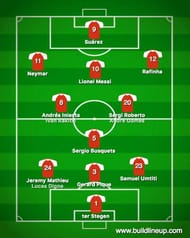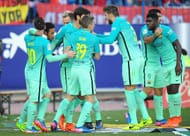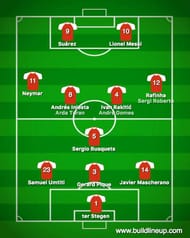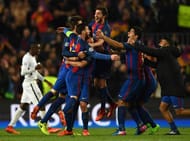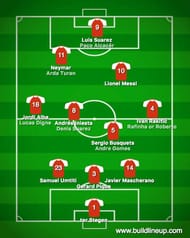After the drastic change by Luis Enrique to the 3-4-3 formation for the matches against Atlético Madrid and Paris Saint-Germain, many were left wondering as to what was next for the Catalans.
Would the 4-3-3 be brought back with Sergi Roberto at right back or would Lucho continue with the 3-4-3 which had worked extremely well against PSG and Atlético Madrid? In this article, we delve deeper into the formations played against the Parisians and the Rojiblancos to see if they are a perfect fit for the team.
3-4-3 against Atlético Madrid
The 3-4-3 was more of a make-shift change to counter the threats posed by the two teams. Against Atlético, the 3-4-3 shifted to a 4-4-2 in defence with Roberto tracking back to the right back position and one of the three centre-backs taking the left back position.
In the midfield, Lionel Messi played at the tip of the diamond while Rafinha played as a wide winger. Sergi Roberto and the captain, Andrés Iniesta, played the sacrificial lambs as box-to-box midfielders. Neither of them was cut out for the role though and that severely hindered their creativity. However, for the type of 3-4-3 Lucho was employing, two box-to-box midfielders were needed.
Right from the outset, there were several problems with this formation. Firstly, Atlético did not wait for the 3-4-3 to transition into a 4-4-2 to start attacking. As soon as the ball was lost, Atlético started its lightning quick counter attacks. Roberto was often caught high up the field, and in those instances, Gerard Pique had to cover the right flank. Gaps in the defence were created which, on any other day, could have been exploited.
Messi’s role as a free-roaming playmaker at the tip of the diamond, while theoretically ideal, was far from it. The area he occupied was between the two lines of defence. That area was extremely overcrowded. That forced him to drop deep, and the deeper he got, the less effective he became.
With the 4-3-3, Messi played as a right winger where he had a lot of time and space to influence the game. This, coupled with his telepathic understanding with Dani Alves, allowed him to drift inside and influence play while Alves overlapped and took his place on the right wing.
Without a right back in the 3-4-3, the Argentine cannot play on the right side because there is no one to take his place on the right wing. Hence, in the match, his role was limited to the centre of the pitch. Although Barcelona did come out with a win, it was an extremely unconvincing one due to there being no coherent structure in their play.
3-1-4-2 against Paris Saint-Germain
In this match, Luis Enrique decided to experiment further with the 3-4-3 by converting it into a 3-1-4-2. This change allowed the midfield to be overloaded with Barça players. The Brazilians, Neymar and Rafinha, dropped to the midfield to provide width while the three centre-backs were also stretched to provide space to attack through the flanks.
Barcelona pressed extremely high and Enrique left no room for any mistakes while pressing. Each member was assigned an opposition player – Messi and Suárez, the two strikers had the two PSG centre-halves to take care of, the wingers had the PSG fullbacks while the players in the centre marked the respective players in their zone. 3-1-4-2 was the perfect solution to the 4-2-3-1 that PSG employed.
However, that night, PSG and Unai Emery only had themselves to blame as they started off the match defending too deep. They came to the Camp Nou and parked the bus with a 4-5-1 formation.
This was a tactical disaster as Enrique had predicted this beforehand, and hence gave more importance to the wings. With a 4-5-1, PSG tried to cut the breathing space in the middle but Lucho starved that part of the pitch and instead opted to build plays through the flanks.
Neymar had one of the best games of his life due to this tactical plan. At one point in time, Barcelona transformed into a 3-3-4 and even a 2-3-5 with the 30-year-old Gerard Pique joining the attack in the final 10 minutes.
The tactical flaws in this plan would have been exposed in literally any other game. Emery’s problem was that he came to the Nou Camp to defend right from the beginning. This allowed the midfield, and even the Barcelona defence to literally just walk over to the PSG half without receiving any counter-press or any form of resistance whatsoever.
Also read: Barcelona 6 - 5 PSG: Is this the greatest comeback of all time?
One of the greatest problems of having a high defensive line is the fact that a perfectly timed run and one long ball can kill the entire game. PSG did not even attempt to do that.
However, after the 3rd goal, Emery decided to shake things up a bit. He instructed his attackers to go out and attack for the first time in the game. This is when Barcelona’s defensive frailties were exposed. Up to that point, Umtiti was doing extremely well covering the left flank. However, as the attacks increased in number, the back three crumbled.
This system was not created to defend. In ten minutes, PSG had scored a goal and Barcelona were back to square one, needing three more goals to get through. Unfortunately, immediately after the goal, the French side went back to parking the bus.
With the three man defence and no wing backs, the flanks are left wide open for wingers from the opposition to come in and seize. On that specific day, the Parisian wingers dozed off.
This system was not created to defend. The comeback against Paris Saint-Germain was more because of the Parisians bottling it than anything. The last 10 minutes of the game are a testament to that.
The road ahead
Playing a 3-4-3 against Juventus in the Champions League quarter-finals would be suicidal. The wing backs, Dani Alves (yes, it hurts to see his name mentioned in any other team) and Alex Sandro, along with Juan Cuadrado would stretch the defence in no time with their pace, leaving Higuain and Dybala to do the damage in the middle.
It would be unfair for Enrique to ask Neymar to take care of the defensive and the offensive duties on the left flank. The right flank, meanwhile, would be dead and the midfield would be pressed by the Juve players from deep positions.
Another problem with the 3-4-3 is that wingers would have to hug the touchline. Usually, with Barcelona, Neymar and Messi can cut in because the full backs usually overlap. This creates an overload in the opposition box with all three of the MSN trio lingering around the goal.
With the 3-4-3 this is not possible as there are no full backs. The only time either of them can cut in is when they have the ball. Even then there is a risk of a turnover and the opposition starting the attack from the flanks.
Also read: Barcelona – The impossible job
The traditional 4-3-3 cannot be brought back without a proper right back, and at this point, Lucho has no traditional right back. Sergi Roberto has publically stated that he does not want to play at right back anymore and he has the option to play the 32-year-old Mascherano at that position but that would slow down the right flank considerably. Messi would not be able to play his defence-splitting balls as there would be no one to cover his wing and that would hinder his ability to cut in.
Moreover, this season, Barcelona’s 3-man midfield has been a disaster. Injuries to Don Andrés and Rakitic have meant that Lucho has had to change his plans several times. André Gomes is one player that has been singled out as more of an antagonist in this current team after his sudden summer transfer to Barcelona.
Denis Suarez, while looking promising at first, has looked more ordinary as the season has progressed and Rafinha, while putting in solid performances, isn’t at the level of Rakitic, Busquets or Iniesta.
One way out for Barcelona is to play a 3-4-3 that looks something like this:
Jordi Alba has had his fair share of criticism this season but this is a role he would shine in. He would provide attacking prowess, allowing Neymar to slip into dangerous positions while also allowing the back three to maintain defensive stability.
Alba’s pace and stamina are unparalleled in the team and he would be able to boss the left flank, if and only if, he is able to adapt to the role. On the right flank, Rakitic (or Rafinha/Roberto) can allow Leo to drift in which would allow him to make use of the right wing.
Rakitic, being a box-to-box midfielder would have the lungs to track back and help contribute defensively, and in cases where he isn’t able to, Busquets can drop to defence with Mascherano moving to the right. This, essentially gives the front three a chance to run riot as the ball will be recycled quickly from defence to attack through the flanks.
While this might not be the only way forward, it seems to be the best way. Regardless of what path Luis Enrique chooses to take, he is going to have a real selection headache with an extremely busy April coming up.

